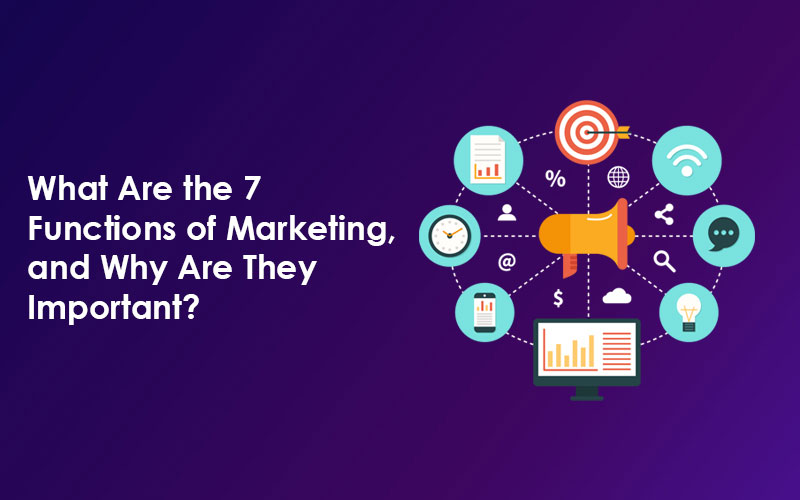Welcome, fellow marketing enthusiasts, to a journey through the captivating realm of marketing, where you make your product or service stand out in front of your audience. While many people believe the sole purpose of marketing is to promote the product or service to make, the audience knows about it. However, marketing goes beyond just flashy tactics in order to reshape your whole business strategy.
In this blog post, we will explore 7 functions of marketing, each playing a crucial role in transforming business destinies. We’ll delve into the captivating world of product management, uncovering its role in understanding the desires and aspirations of consumers. Discover how businesses utilize these insights into groundbreaking products and position them to steal the limelight.
What Are the Functions of Marketing, and Why Are They Crucial for Businesses?
For any business strategy, it requires a certain process or steps to make the end product fine and running. Similarly, marketing isn’t just only about flashy ads and persuasive sale pitches, but it requires several steps and functions to enjoy its outstanding perks.
Functions of marketing include promotion, selling, product/service management, pricing, marketing information management, financing, and distribution. These functions are crucial in making your business successful in this competitive business landscape. From promoting your brand to distributing your products to longing customers, marketing plays a great role in utilizing your business revenue to generate remarkable results.
The Ingenious 7 Functions of Marketing!
- Promotion
- Selling
- Product/ Service Management
- Pricing
- Marketing Information Management
- Financing
- Distribution
So, let’s delve into the depth of understanding the 7 functions of marketing and their role in crafting a successful marketing strategy:
1. Promotion
Promotion is the gateway to brand recognition and awareness. Promoting your brand could be done in various ways. Whether through digital marketing channels such as social media marketing, content writing, PPC ads, SEO, or email marketing or through traditional marketing tactics such as billboards, TV ads, or word-of-mouth.
According to a survey conducted by Nielsen, 59% of consumers prefer to buy products from familiar brands. Furthermore, Promotion extends its impact toward more conversions and customer engagement. Through search engine optimization and PPC ads, brands can catapult their product or services in front of their potential customers, ultimately generating maximum conversions and sales.
Moreover, promotion also contributes to building trust and credibility for a brand. A survey by Edelman found that 81% of consumers say they must trust a brand before making a purchase. Promotional efforts that focus on providing value, authentic messaging, and customer testimonials can help build this essential trust with consumers.
However, promotion is not solely about acquiring new customers; it also nurtures customer loyalty. A study by Yotpo reveals that over 90% of Gen Z stay loyal to brands that share their values. When promotions resonate with customers’ preferences and needs, it strengthens the emotional bond, fostering brand loyalty and repeat purchases.
2. Selling
Selling isn’t just the role of respective salespersons, but it comes under the umbrella of 7 functions of marketing. Effective selling involves building and maintaining strong customer relationships, offering personalized solutions, and continuously providing value to buyers. By doing so, businesses can maximize their ROI and achieve sustainable success.
Moreover, the function of selling intertwines with other marketing functions, such as promotion and market information management. Salespeople rely on promotional materials and market insights to effectively tailor their approaches and connect with potential buyers. By leveraging these marketing resources, the sales team can elevate their pitches and adapt to changing customer preferences.
Additionally, selling plays a pivotal role in gathering crucial feedback from customers. Through customer interactions, sales teams gain valuable insights into market trends, competitors, and areas for improvement. This market intelligence becomes a valuable asset for other marketing functions, enabling businesses to refine their strategies and remain competitive.
3. Product/ Service Management
Refining your products and shaping them to your customer’s needs isn’t a childsplay. It requires a whole lot of effort and strategies to make sure your product and services resonates with your audience. Marketing takes center stage in managing products or services to let your brand yield the standing it deserves.
At the heart of product/service management lies innovation – a continuous process of improvement and creation. This function identifies market gaps, envisions new solutions, and develops offerings that captivate the audience’s imagination. By adapting to ever-changing customer needs and technological advancements, Marketers would be able to keep businesses relevant and competitive.
Product/service management revolves around customer-centricity, listening keenly to the audience’s desires and pain points. Businesses that align their offerings with customer preferences attract new buyers and foster loyalty among existing ones.
The function of product/service management is the guardian of quality, ensuring that offerings meet or exceed customer expectations. By implementing rigorous quality control measures, businesses can establish a reputation for reliability and excellence. In the eyes of consumers, a commitment to quality elevates a brand’s trustworthiness and credibility.
Like a seasoned conductor, product/service management oversees the entire lifecycle of offerings. This function strategically manages each phase from the launch to maturity and possible retirement. By constantly evaluating performance and adapting strategies, businesses can prolong the lifecycle of successful offerings and make well-informed decisions about reinvestment or replacements.
4. Pricing
Now, you might be thinking, what pricing has to do with marketing? Like, isn’t it the job of sellers? But let us tell you; pricing is one of the most crucial functions of marketing that has the potential to amplify a business’s success manifold.
McKinsey & Company revealed that a mere 1% increase in price could result in an 8.7% increase in operating profits for an average company. Effective pricing goes beyond merely assigning a monetary value to a product or service. It is a delicate balance between customer perceptions of value and the costs incurred by the business.
For example, strategic pricing can position a business as the preferred choice by offering competitive rates without compromising on quality. It helps businesses to set themselves apart by understanding the pricing landscape and leveraging that knowledge to entice customers.
Marketers leverage the psychological impact of pricing on consumers to generate greater business revenue and sales. For instance, the phenomenon of “charm pricing” (ending prices with .99) influences the perception of a lower price, stimulating purchases.
Thus, through marketing, businesses have the ability to seek the competitiveness of their products or services and their true market value in the eyes of their customers, which lets them set profitable prices.
5. Marketing Information Management
Did you know that 7% of marketers are able to drive data-driven marketing engagements by leveraging data analytics extensively?
In the era of big data, marketing information management empowers businesses to make well-informed, data-driven decisions. Analyzing customer behaviors, market trends, and performance metrics helps extend marketing goals for profitable results.
Marketers and salespersons can discern emerging opportunities through data collection and analysis, identify changing customer preferences, and adapt their marketing approaches accordingly. They gather data from different marketing channels to tweak their sales pitches, ad targeting, and social media marketing to effectively address the concerns of their target audience and drive them toward your products.
Marketing information management provides clarity on the effectiveness of various marketing initiatives. With this knowledge, Businesses can strategically allocate marketing budgets, optimizing resources for the best possible outcomes.
6. Financing
Marketing teams are equipped with the data insights that help them uncover hidden opportunities. That’s why financing is the leading function of marketing because it helps marketers utilize a company’s budgets in effective ways.
Financing allows marketers to allocate resources to promotional activities that create brand awareness, engage customers, and drive sales. From advertising campaigns to social media marketing, funding ensures marketing messages effectively reach their intended audience.
Moreover, careful planning and budget allocation support product development and innovation, enabling businesses to introduce new offerings that meet customer needs and desires.
Through financing, businesses attract top talent and invest in training programs that enhance the skills and knowledge of marketing teams. These talented professionals harness the potential to invest in marketing automation, customer relationship management (CRM) software, analytics platforms, and other tools that streamline marketing operations and optimize outcomes.
7. Distribution
The function of distribution in marketing is the vital thread that weaves together businesses and their customers. The function of distribution involves efficient supply chain management. By optimizing inventory levels, order fulfillment, and logistics, businesses can ensure that products are available when and where customers need them. An efficient supply chain enhances customer satisfaction and loyalty.
Distribution channels allow businesses to establish a presence in new markets. Whether it’s partnering with local retailers, setting up online platforms, or entering into strategic alliances, distribution facilitates market expansion and diversification of the customer base.
Marketers analyze the needs of customers and their varying preferences for how they access products or services. Therefore they cater to these preferences by offering multiple channels, such as brick-and-mortar stores, e-commerce platforms, and direct sales, allowing customers to choose their preferred method of purchase.
As consumer behavior evolves, businesses adopt omnichannel marketing strategies to engage customers across multiple touchpoints. Distribution facilitates the execution of these strategies, allowing businesses to deliver consistent experiences regardless of the channel.
Wrap Up:
As you have now understood the 7 functions of marketing and their importance for driving a robust marketing campaign. Now it’s time to implement the advanced knowledge and skills to yield the best results from each function. Whether you are new to marketing or have gained profound knowledge over time, these functions significantly help your business stand out in today’s world. So, let the game move, and if you need any help promoting your brand, feel free to reach out to us!





